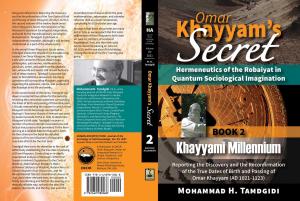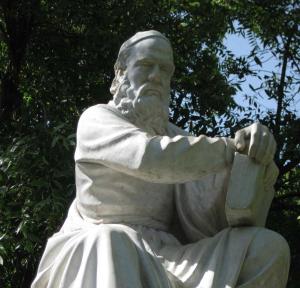Omar Khayyam's True Birth & Death Dates Discovered, His Millennium is Imminent
Khayyam's birth occurred on June 10, AD 1021, at Neyshabour's Sunrise, and his life's circle closed at the end of his 102nd year on his birthday in AD 1123.
The interval between Omar Khayyam's birth Millennium on June 10, 2021, and his death's ninth centennial on his birthday in 2023 provides Iran and world 2 years' time of deserving celebration for him.”
BOSTON, MASSACHUSETTS, UNITED STATES, April 27, 2021 /EINPresswire.com/ -- Book 2 of the OKCIR series "Omar Khayyam’s Secret: Hermeneutics of the Robaiyat in Quantum Sociological Imagination," subtitled "Khayyami Millennium: Reporting the Discovery and the Reconfirmation of the True Dates of Birth and Passing of Omar Khayyam (AD 1021-1123)," will be released on June 1, 2021. Each book is independently readable, although it will be best understood as a part of the whole series. The second book of the series will be published with the first and the third books of the series simultaneously.— Sociologist and Author, Mohammad H. Tamdgidi
In the second book of the series, the transdisciplinary sociologist Mohammad H. Tamdgidi, Ph.D., lays down an essential foundation for the series by revisiting the unresolved questions surrounding the dates of birth and passing of Omar Khayyam. Critically reexamining the manner in which Omar Khayyam’s birth horoscope as reported in Zahireddin Abolhassan Beyhaqi’s "Tatemmat Sewan al-Hekmat" (Supplement to the Chest of Wisdom) was used by Swāmi Govinda Tīrtha in his "The Nectar of Grace: Omar Khayyam’s Life and Works" (1941) to determine Khayyam’s birth date, Tamdgidi uncovers a number of serious internal inconsistencies and factual inaccuracies that prevented Tīrtha (and, since then, other scholars more or less taking for granted his results) from arriving at a reliable date for Khayyam’s birth, hurling Khayyami studies into decades of confusion regarding Khayyam’s life and works. Tamdgidi then shares in the book the detailed account of his own discovery of Khayyam’s true date of birth for the first time, a finding that eluded Khayyami studies for centuries and is bound to revolutionize the studies for decades to come.
Tamdgidi then turns his attention to the task of definitively establishing the true date of passing of Omar Khayyam. Conducting an in-depth, superposed analysis of Beyhaqi’s "Tatemmat Sewan el-Hekmat" (Supplement to the Chest of Wisdom), Abdorrahman Khazeni’s "Mizan ol-Hekmat" (Balance of Wisdom), Nezami Arouzi’s "Chahar Maqaleh" (Four Discourses), and Yar Ahmad Rashidi Tabrizi’s "Tarabkhaneh" (House of Joy), amid other relevant texts, Tamdgidi succeeds in firmly reconfirming and further discovering, in a textually reliable way, not only the year, the season, the month, and the day, but even the most likely time of day at which the poet mathematician, astronomer, and calendar reformer died as a solar centenarian, completing his 102nd solar year age.
Regarding the book's historically unprecedented findings, Tamdgidi writes, "… there was one, and only one, date between years AD 1018 and AD 1055 that definitively fulfilled all the requirements of Khayyam’s reported horoscope. This date was, in the Gregorian calendar, June 10, AD 1021, at sunrise, Neyshabour’s time. It was nearly a four minute period from 4:43:56 a.m. to 4:47:55 a.m. exactly at sunrise." Regarding determining Omar Khayyam's time of death, moreover, Tamdgidi states, "we do not have to absurdly borrow a 'Muharram 12th' trick from a mistaken date of passing clearly intended as (also a mistaken) date for birth in Rashidi Tabrizi’s Tarabkhaneh to set an exact date of passing for an astronomer and calendar reformer genius that was Omar Khayyam. He deserves better." Tamdgidi further states that his findings "can provide us with an opportunity for establishing a textually-reliable date of passing on his birth date, one that closes the circle of coming and going of his life. The dates of his passing would be as follows: June 10, AD 1123 (Gregorian), Khordad 20, 502 SH (Persian solar)."
According to the author, "a significantly new door has opened for Khayyami studies now for understanding the life and works of Omar Khayyam. In my view, this discovery is bound to change everything we have read and known about Khayyam over the past millennium since his birth, discovering new things about him, and about what truths he wished to convey, secretly or not, to humanity through his synoptic writings. We have now entered a completely new, unchartered territory in Khayyami studies."
Strange is that these discoveries are made just in time as we ourselves approach on June 10, 2021, the first solar millennium of Omar Khayyam’s birth date on June 10, 1021, at sunrise of Neyshabour, Iran, and on June 10, 2023, the ninth solar centennial of his passing on June 10, 1123, on the eve also of his birthday, closing the circle of his life’s “coming and going.”
——————————————————————
I’m he who from Thy power to existence came,
And amid Thy kind bounties a hundred became.
For hundred more years test my sins to see what’s more:
These misdeeds or Thy mercy forgiving the same.
— Omar Khayyam (Tamdgidi translation)
——————————————————————
About the Author:
Mohammad H. (Behrooz) Tamdgidi, Ph.D., is the founding director and editor of OKCIR: Omar Khayyam Center for Integrative Research in Utopia, Mysticism, and Science (Utopystics) and its journal, "Human Architecture: Journal of the Sociology of Self-Knowledge" (ISSN: 1540-5699), which have served since 2002 to frame his independent research, pedagogical, and publishing initiatives. Tamdgidi holds a Ph.D. and M.A. in sociology in conjunction with a graduate certificate in Middle Eastern studies from Binghamton University (SUNY). He received his B.A. in architecture from U.C. Berkeley. He has previously also authored "Advancing Utopistics: The Three Component Parts and Errors of Marxism" (Routledge/Paradigm) and "Gurdjieff and Hypnosis: A Hermeneutic Study" (Palgrave Macmillan). He is a former associate professor of sociology specializing in social theory at UMass Boston and has taught sociology at SUNY-Binghamton and SUNY-Oneonta. Due to research commitments facing urgent deadlines, and preferences for written communication and privacy, the author can be reached only by email. All he wishes to share are done through his publications.
Mohammad H. Tamdgidi
OKCIR: Omar Khayyam Center for Integrative Research
pressrelease@okcir.com



